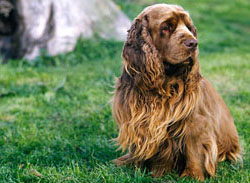Sussex Spaniels have an abundant golden liver coat that is unique to the breed. The coat is slightly wavy or flat, and the rich golden liver coloring is the only acceptable coat color and is a sign of the breed's purity. These dogs have large, hazel eyes and heavy brows. Their ears are thick and large. Sussex Spaniels measure 13 to 15 inches tall at the shoulder and weigh 35 to 45 pounds.
Regardless of how somber they may sometimes appear, these dogs tend to be quite cheerful and are generally content with the world.
Cheerful and friendly, even though they often appear somber and serious, Sussex Spaniels make great pets for families with children. These dogs need regular brushing, but they are easy to care for and enjoy family walks and relaxed play sessions.
The Sussex Spaniel remains one of the rarest of dog breeds, even though it was one of the original nine breeds the AKC recognized in 1884.
Relaxed and calm for a spaniel, the Sussex enjoys hanging out around the house and spending time with family. These friendly and open little dogs are very loving and affectionate and they make devoted pets. They get along especially well with children, although Sussex Spaniel puppies may be too rambunctious for toddlers.
As loving as they are, these dogs tend to be less demonstrative than other spaniel breeds. They may also be less energetic and playful. This makes them a good choice for city apartments and small homes. Regardless of how somber they may sometimes appear, these dogs tend to be quite cheerful and are generally content with the world.
Sussex Spaniels need daily exercise in the form of long walks on a leash or free play in a securely fenced yard. While these dogs do well in apartments, they should have access to open space for occasional running and romping. Sussex Spaniels may howl and bark, sometimes excessively, making them good watchdogs but unappealing neighbors.
Sussex Spaniels are known to be affected by a few potentially serious health conditions that can negatively affect length or quality of life. Acquiring one of these puppies from a reputable source who provides a detailed medical and family history is important.
The breed is known to suffer from ear infections, deafness, hypothyroidism, and hip dysplasia more than some other dog breeds. Heart problems, such as murmur, enlarged heart, cardiomyopathy, and pulmonic stenosis, are also seen in these dogs. Eye problems, including entropion and retinal dysplasia, are other concerns. Additionally, these dogs are prone to an exercise intolerance syndrome, called pyruvate dehydrogenase deficiency, that is present in 20 percent of Sussex Spaniels. Females may require Caesarean sections.
Sussex Spaniels generally live 10 to 15 years, provided they receive routine veterinary care, timely vaccinations, regular exercise, and proper nutrition.
Very intelligent and not the easiest to train, Sussex Spaniels respond well when provided with the right motivation. Of course, it can take a while to determine exactly what that is for each individual dog. Generally, this breed responds well to positive reinforcement techniques, such as play, praise, and food rewards. In fact, food rewards typically top the list of things that excite the Sussex.
Housetraining these dogs may also be challenging. The process can take a long time, especially for females. Consistency and patience are key. This breed matures slowly, and it's important not to expect too much, too soon.
For Sussex Spaniels to grow into confident, tolerant, and calm adults, they need early and frequent socialization. During the first year of life, this can take the form of puppy kindergarten and trips to the dog park. Later in life, walks around the neighborhood, visits to neighbors' homes, and trips to local businesses will help.
Grooming the Sussex Spaniel isn't too hard or time consuming. Brushing a couple of times each week is generally sufficient to prevent tangling and matting, but daily brushing is usually needed during shedding seasons to keep loose hair under control. These dogs also need a daily coat check to look for sticks and other debris that may be caught in their hair. Scissoring every few months is recommended.
These dogs drool a lot, and this can result in sticky, dirty, or matted hair around their mouths. Regularly cleaning and drying the hair on the face and neck will help. Unless the Sussex Spaniel gets into something sticky, stinky, or harmful, bathing is rarely necessary.
The nails need clipping every week or two to prevent potentially painful snags and breaks, and the teeth should be brushed daily to improve breath odor and keep away cavities and gum disease. Weekly ear checks to look for signs of infection or accumulation of ear wax are also important.
Sussex Spaniels originated in the 18th century in Sussex, England, where the breed was used as a field dog. The dogs were developed by a breeder named Fuller, with the intention of the breed becoming a sporting dog. However, it was not notably boisterous or fast.
Sussex Spaniels became popular hunting companions due to their good nose, although the breed's slow speed made it less desirable among American hunters. Although the Sussex was one of the first breeds recognized by the AKC and one of the first to compete, it has never been very popular or competitive. This lack of popularity is one reason for the breed's dangerously low numbers; the Sussex has spent most of the 20th century near extinction.
Today, these dogs are primarily kept as companion animals, although they can still be found in the role of hunting companion. While still rare, the breed's numbers are growing in both Great Britain and the United States.

